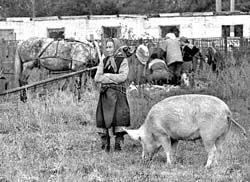What does a rural household live off?

Ukraine is known throughout the world as a state that is striving for European standards. At first glance, this is the right direction, and something has even been done to this end. But why is the countryside so poor? Why is the struggle for survival a daily routine here?
“We are just trying to survive,” says my mother’s closest neighbor, Nadia Khyzhniak, a gray-haired, careworn woman, digging some kopecks out of her purse with gnarled fingers. She lives in the village of Kalininske, Lypova Dolyna district, Sumy oblast, and she is no exception. Her life is typical of most people living in the neighboring villages. People survive here only by raising pigs because there is practically no other work. The lessees of the villagers’ plots of land employ 50 to 60 people, while there are at least 300 able-bodied peasants here.
Let’s take a look at the expenditures of a peasant household. Much to the surprise of urban dwellers, a fattened pig is the best farming currency. Fuel is the most expensive budgetary item. In the winter gas costs 300 hryvnias a month, and coal, more or less the same amount. That is why every household raises a special 200-kg hog “for fuel.” It can be converted into hard cash (6 to 7 hryvnias per kilo of live weight), and you can make all payments on time — otherwise your water supply may be cut off for unpaid bills.
Working on your private plot of land also entails heavy expenditures. It will take another hog to plow and sow the land, remove the manure, and wine and dine the tractor driver (pesticides are a non- issue for now because the hoe is irreplaceable here). There is also another option: to hire a horse- drawn plow. This will not be much cheaper, but will take a longer time and give a lower quality of plowing. So people spare no money for the “iron horses.” In the fall you have to invite a harvester driver. But it is still doubtful that your second “pet” will gain the necessary weight. This is where peasant debts begin. And what if the crop fails, God forbid?
A third hog is usually raised for children, who have to be fed, clothed, shod, and supplied with school supplies. Also, even in a village you cannot do without a cell phone, and the bills for it have to be paid regularly. Villagers sometimes call the pig a sacrificial animal. The point is that there are usually two children in a family, and parents can afford to give meat only to them, while they themselves go on a diet of “Cossack food — bread and water.”
In addition, this source of funding is also used when you need to buy your dear cow some presscake, hay, straw, and even grain (the grain you’ve grown by yourself as payment for your plot of land is usually insufficient). You also have to go shopping, because you can’t do without bread and salt (you will also buy sardines and herrings to diversify your potato- based diet). All this requires money, and this poor little hog will provide it.
The fourth animal is also placed on the altar of education: it is an investment in the future of older children. Admittedly, this is the best investment. Ordinary rural parents are aware that their child has nothing to do in the village. So they regularly support the student, if their child has managed to become one, with fatback and hard cash.
Meanwhile, there is a final, fifth, budgetary reserve in the barn. What about that one? There is no alternative. After it is fully grown, it will be traded for five piglets. If a peasant is lucky, he can buy a sixth pig — for reproduction or insurance (in case of inflation). People never know if they will manage to raise all the piglets. It’s not just a question of fodder but diseases.
And what money is left for when a family member gets sick and has to see a doctor, or pay for a prescription that cost a fortune? So peasants don’t go to doctors and don’t buy medicine, because they haven’t got the time either. They have to start again from square one. The first one, second one, third one, etc.






